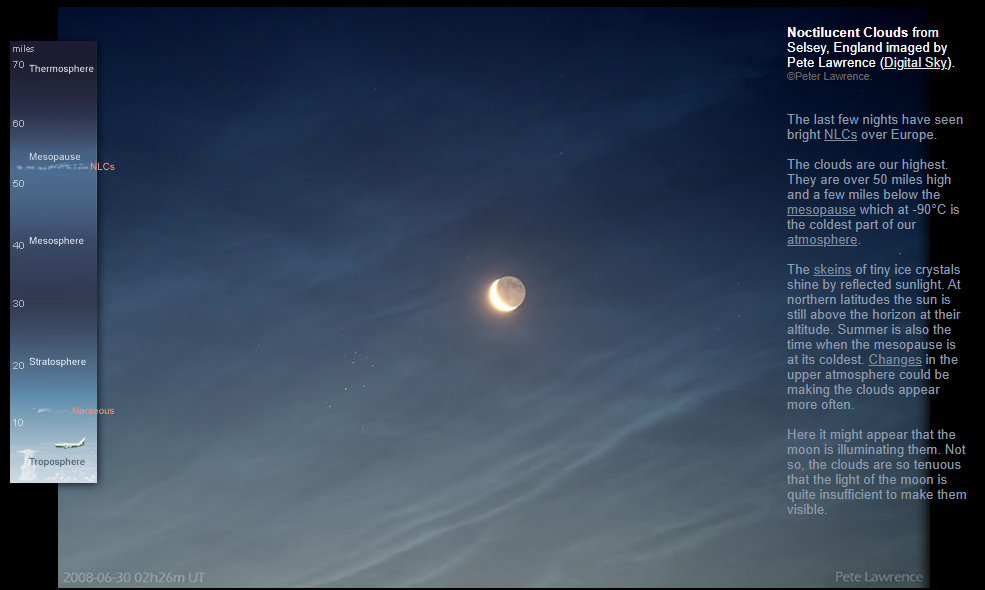NLCs, Pleiades, Moon
NLCs, Pleiades, Moon: Unveiling the Mysteries of Noctilucent Clouds
Noctilucent clouds (NLCs) have been captivating observers in Europe with their ethereal beauty. These mesmerizing clouds, situated at an astonishing height of over 50 miles and just a few miles below the mesopause, the coldest part of our atmosphere at -90°C, hold a sense of intrigue and wonder. While their appearance may seem influenced by the moon's illumination, it is important to note that the moonlight alone is insufficient to make them visible. In this article, we will delve deeper into the enigmatic world of NLCs, exploring their formation, characteristics, and the potential factors contributing to their increased frequency.
NLCs are composed of delicate skeins of tiny ice crystals that gleam under the reflected sunlight. At these extreme heights, the sun remains above the horizon even during the night at northern latitudes, allowing for the mesmerizing display of these luminous clouds. Their presence is particularly prominent during the summer months when the mesopause reaches its lowest temperatures. However, recent changes in the upper atmosphere have sparked curiosity about the increased frequency of NLC sightings.
To comprehend the mechanisms behind the formation of NLCs, we must first understand their unique characteristics. These clouds are situated in the mesosphere, the layer of Earth's atmosphere located between the stratosphere and thermosphere. They appear as thin, bluish-white filaments or wisps, delicately tracing across the night sky. Due to their high altitude, NLCs are illuminated by sunlight from below the horizon, creating a breathtaking spectacle for those fortunate enough to witness them.
The formation of NLCs is a complex interplay between various atmospheric conditions. It begins with the presence of water vapor and dust particles in the mesosphere. During polar summers, when the mesopause reaches its coldest temperatures, the water vapor condenses onto the dust particles, forming ice crystals. These ice crystals then aggregate to create the intricate structure of NLCs. The unique combination of extreme cold, water vapor, and dust particles is essential for their formation.
While the exact reasons for the increased occurrence of NLCs remain uncertain, scientists have proposed several hypotheses. One theory suggests that changes in atmospheric circulation patterns and the distribution of water vapor may contribute to their heightened frequency. Another possibility is the influence of human activities, such as the release of greenhouse gases and changes in the composition of the upper atmosphere. Further research is required to fully comprehend these phenomena and unravel the mysteries of NLCs.
Observing NLCs offers more than just a visual spectacle; it provides valuable insights into Earth's upper atmosphere. Scientists study these clouds to better understand the dynamics and composition of the mesosphere. By analyzing their formation and behavior, researchers can gain knowledge about the interplay between various atmospheric layers and potentially uncover indicators of climate change.
In conclusion, Noctilucent clouds are a captivating phenomenon that grace the night skies with their ethereal beauty. Their presence at such extreme altitudes and unique characteristics make them a subject of fascination and scientific inquiry. While their increased frequency remains a mystery, ongoing research aims to shed light on the factors contributing to their appearance. As we gaze upon these celestial wonders, we are reminded of the vast complexities that exist within our atmosphere and the endless mysteries waiting to be unraveled.

Noctilucent Clouds from Selsey, England imaged by Pete Lawrence (Digital Sky). ©Peter Lawrence.
The last few nights have seen bright NLCs over Europe.
The clouds are our highest. They are over 50 miles high and a few miles below the mesopause which at -90°C is the coldest part of our atmosphere.
The skeins of tiny ice crystals shine by reflected sunlight. At northern latitudes the sun is still above the horizon at their altitude. Summer is also the time when the mesopause is at its coldest. Changes in the upper atmosphere could be making the clouds appear more often.
Here it might appear that the moon is illuminating them. Not so, the clouds are so tenuous that the light of the moon is quite insufficient to make them visible.
Note: this article has been automatically converted from the old site and may not appear as intended. You can find the original article here.
Reference Atmospheric Optics
If you use any of the definitions, information, or data presented on Atmospheric Optics, please copy the link or reference below to properly credit us as the reference source. Thank you!
-
<a href="https://atoptics.co.uk/blog/nlcs-pleiades-moon/">NLCs, Pleiades, Moon</a>
-
"NLCs, Pleiades, Moon". Atmospheric Optics. Accessed on November 26, 2024. https://atoptics.co.uk/blog/nlcs-pleiades-moon/.
-
"NLCs, Pleiades, Moon". Atmospheric Optics, https://atoptics.co.uk/blog/nlcs-pleiades-moon/. Accessed 26 November, 2024
-
NLCs, Pleiades, Moon. Atmospheric Optics. Retrieved from https://atoptics.co.uk/blog/nlcs-pleiades-moon/.